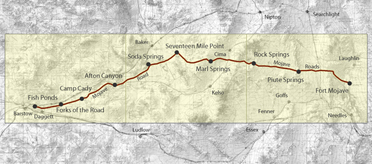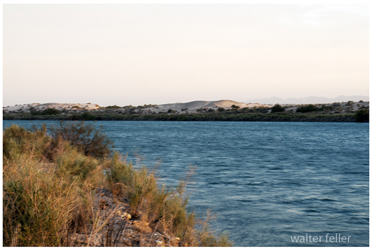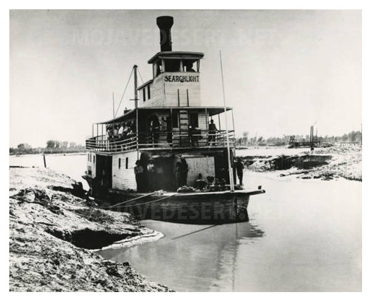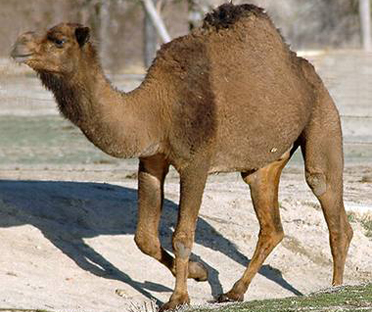History of Eastern Mojave & the Mojave Road
The Mojave Desert has long been crossed by human transportation routes. The Mojave Road
refers to a particular corridor used to traverse this dry expanse. Originally used by
Desert Indians, and later by
Spanish and
American explorers
and
travelers,
the road was named by the
U.S. Military
when it established several outposts along the
militarily protected road.
Water is the primary determinant of travel in the desert. It is relatively plentiful
along the California coast and at the
Colorado River,
so the trick is to find water in
between. There are a string of
watering holes or springs
-
Piute,
Rock,
Marl,
and Soda -
that move into the
Mojave River
system and make for a natural travel route across this
region. This would be the route later called the Mojave Road.
At the time of European contact, the peoples that lived along the
Colorado River
(near present day
Needles, California) were the
Mojave Indians. They used this
corridor extensively to move goods from the Southwest, in exchange for goods from
coastal Indians such as the Chumash. The Mojaves appear to have been extraordinary
strong travelers, and were famous as desert traders.
As you moved away from the
Colorado River, you entered the territory of the
Chemehuevi Indians
who also used the route. In earlier times the Anasazi culture and
economy, centered in New Mexico and Arizona, had an impact here. They had turquoise mines
in the area, and traded for goods from the California coast. In all likelihood they also
used the Mojave Road, as did other
Indian tribes
through the centuries.
One of our first records of the route comes from the pen of
Father Francisco Garces.
Spanish colonization was moving northward from Mexico, and Garces, then a priest
stationed at Mission San Xavier del Bac, accompanied an expedition up the
Colorado River
and then through the desert to the San Gabriel Mission.
They moved upstream until they "reached the
territory of the Jamajab (Mojave) nation."
There , he said, "I showed them the paintings of the Virgin, which pleased them very much;
of the Damned Man they said that he was very bad. I was the first Spaniard to enter their
land, at which they rejoiced greatly on account of their desire to know us. They had
heard said that we were brave, and they showed extraordinary pleasure at being friends
of so valiant a people."
"I laid before them my desires to visit the Fathers living near the sea; they gave assent
and offered to accompany me, for they had heard of them and knew the way." They soon set
out across the desert "through a flat and grassy country and came to a mountain range
(Providence Mountains) with small pines; I called it the Sierra de Santa Coleta. The
watering place has little yield and is high up....Here I met four Indians who had come
from Santa Clara to traffic in shell beads. They were carrying no food supply nor even
bows for hunting. Noticing my astonishment at this, where there is nothing to eat, they
said 'we
Jamajabs can withstand hunger
and thirst for as long as four days,' giving me understanding that they were hardy men." Garces
successfully crossed, but made little lasting impact on the desert.
In the 1820s, there was another brief period when
explorers
associated with the fur
trapping trade entered the desert. The legendary explorer
Jedediah Smith
used Mojave Indian guides to cross the
Mojave corridor over to the coast. Another group of trappers precipitated a conflict with
the
Mohave Indians
in which numerous people were killed on both sides, perhaps indicative
of what was to come. This traffic soon died down as the fur trade collapsed.
In 1848, as a consequence of the Mexican-American War, the United States acquired nearly
half of Mexico. Now the
Mojave Desert
along with the entire Southwest was American territory,
and an expanding nation looked to consolidate its hold on the land. Transportation was seen
as critical. Several surveys were dispatched to select potential routes, both for roads and
railroads, and the Mojave Road was seen as a natural route across the desert.
One of the most colorful episodes was the camel expedition under
Edward Fitzgerald Beale.
Camels work well in the Old World desert, so why not here? - or so the reasoning went. A ship
was sent off to the Middle East to buy several breeds of camels, and they were brought back
to United States and promptly marched across Texas, New Mexico, Arizona and then California
across the Mojave Road. They did very well in the desert, but there was one problem. They
scared the daylights out of the horses they crossed along the way. Since there were a lot
more horses around than camels, it was written off as a bad experiment.
After the Civil War, traffic along the Mojave Road picked up considerably. Prescott was the
capital of Arizona, so it was critical that a protected route be developed so mail and other
essential items could be brought in from the California
coast. Native-Americans
had suffered greatly under American occupation, and many young men were now turning their fury against the
new conquerors. The Mojave Road crossed
Chemehuevi
and
Mohave
territory, and attacks on
travelers was common. The
U.S. military
responded with
Major General J. H. Carleton
establishing forts along the Mojave Road. Within
Mojave National Preserve
stood military outposts at
Soda Lake (Hancock's Redoubt),
Marl Springs,
Rock Springs,
and
Piute Springs.
Nearly as soon as the road become established as an official route, forces began to work
against its existence. Steamships could maneuver up the
Colorado River
beyond where it
crossed the Mojave Road. Cargo could be carried by ocean vessels and then up the river by
steamboat, completely bypassing the route across the Mojave. A more serious blow came in
1883 when another trans-continental railroad, todays Burlington Northern/Santa Fe, was
completed just south of the Mojave Road. The march of progress had brought more effective
means of transport. What had been the most effective route across the Mojave for centuries,
now became a forgotten dirt path through the desert.
Source - National Park Service





